Waukesha Christmas-Parade Trial, Day Four
Anastasia Katz, American Renaissance, October 12, 2022
Darrell Brooks, the mass murderer who drove through the Waukesha Christmas parade, started the fourth day of his trial by claiming he is not Darrell Brooks. He began this tactic the day before, but didn’t say who else he might be. Judge Jennifer Dorow declared the record should reflect that he is the individual known as Darrell Brooks. When she called the defendant “Mr. Brooks” later, he said, “I object to being called that name. I am a living and breathing human being.” Perhaps he will claim that Darrell Brooks is dead and that he is someone else.
In spite of this, Mr. Brooks got through a discussion of issues such as filing subpoenas. He also talked to the judge about “subject matter jurisdiction,” and calmly accepted her ruling that, after reviewing a number of cases he had cited, the court has no obligation to provide proof of jurisdiction.
This has to do with which cases — civil, criminal, family, probate, etc. — are tried in which courts. Darrell Brooks faces criminal charges, so he is in criminal court. Perhaps he is trying to convince the judge that this should be a civil case. Perhaps he misinterpreted something he read and believes that subject matter jurisdiction is a way to get his case dismissed.
He also had a reasonable discussion with the judge about the fact that some witnesses will need interpreters and will be taken out of order.
The videos of Mr. Brooks running people over in his mother’s red SUV are graphic and are not being aired on television. There are three different angles of his car running over the high school band, and on the previous day, the jury had to watch them over and over. A male juror in his 40s put his head down, and a woman had to get up and leave.
The first witness on this day was Kelly Grabow. She and her daughter marched in the parade as characters from the movie How the Grinch Stole Christmas. She noticed sounds getting louder and that the crowd was not cheering. She turned to check on her daughter, and saw the hood of a red vehicle, which knocked her down. She saw a tire go right in front of her face.
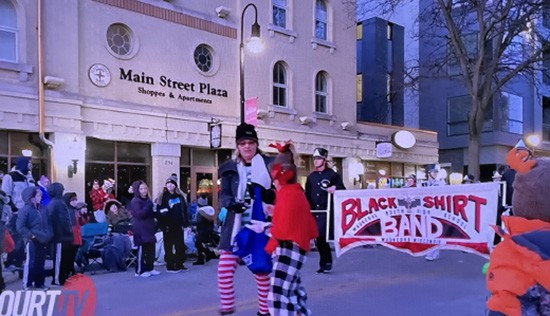
She found her daughter in the middle of the road, where people were trying to help her. The girl’s shoes and glasses were knocked further down the road. Video showed Mrs. Grabow and her daughter being hit by the car, as people shouted “Oh my God!” Mrs. Grabow rode in the ambulance with her daughter to the hospital, where the girl was treated for massive bruising up and down her back, a broken hand, and “road rash” all over her face. Mrs. Grabow herself had ligament damage in her knee and her hand.
On cross-examination, Mr. Brooks asked Mrs. Grabow how she was able to help her daughter with an injured knee. Mrs. Grabow said adrenaline had kicked in. After asking several reasonable questions, he went back to his line of questioning about the plaintiff. He asked if the DA told her who the plaintiff is, if she talked to the plaintiff, etc. The prosecution objected to these questions several times, and after the judge sustained, Mr. Brooks said, “Grounds,” meaning he was asking for the justification for the objections.
The judge warned him that if he didn’t move on, she would close questioning of this witness. He said, “I will move on, it just has to be some type of grounds other than relevancy or anything like that. The real grounds should be put on record, Your Honor. We all deserve to know. The jury deserves to know.”
“It’s not relevant. Move on,” the Judge said.
He asked Mrs. Grabow if she recovered damages. She said yes. He asked if that was through the state of Wisconsin, but Mrs. Grabow couldn’t remember the name of the fund that helped her. “Are you listed as a plaintiff in this matter?” He asked. She didn’t understand. “Are you the plaintiff? Did you file a claim?” The judge let him go on too long with this line of questioning that perplexes witnesses, prolongs the trial, and probably annoys the jury.
On the state’s redirect, Mr. Brooks objected to her testimony as hearsay several times. Since Mrs. Grabow was testifying about her own experience, her testimony is not hearsay. He asked for a definition of hearsay, but the judge is not obligated to teach him the law.
The next witness was Jeff Rogers, coach of the Blazers Youth Baseball program, who was marching with his team. He described the chaos and terror the red SUV caused as it drove through the group, and how he searched frantically for his three children but was able to find only two. He saw one team member, Jackson Sparks, motionless on the ground with his eyes open. He heard someone yell “shots fired” and “get inside the nearest building,” so he took his two children into a store. He got a text from a friend saying his third child was injured, but safe. Jackson Sparks died.

Jeff Rogers
The jury watched a video of Mr. Brooks driving his car through the team, killing Jackson and hurting many others. Mr. Rogers confirmed that the video depicted his testimony accurately. Darrell Brooks kept his head down while the video played. When the judge called a break and dismissed the jury, Mr. Brooks stood with his head bowed as the jury exited. Before the jury came back, Mr. Brooks wiped his eyes and appeared to cry.
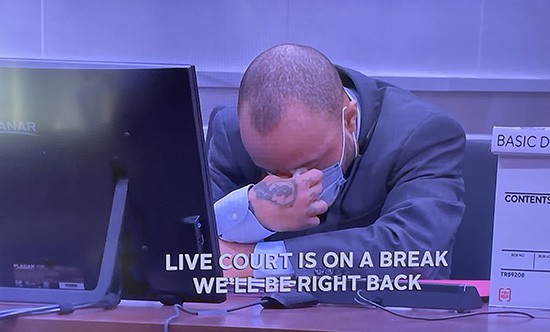
Mr. Brooks has no obligation to cross-examine witnesses, but he has examined them all, even if he does not get answers that help his case. Maybe he doesn’t know he has the option of passing the witness or maybe he thinks his questions help. Maybe he knows he can’t win this case, so he just wants a project outside the jail cell where he knows he is going to spend the rest of his life.
When he began to cross-examine Mr. Rogers, he shuffled some paperwork, looked down, and said “I apologize to the witnesses.” “I’m a little emotional right now,” he added. “I apologize to the court as well.”
Mr. Brooks asked Mr. Rogers if he recalled making a statement to police that his children’s injuries were “minor.” The state objected, saying the defendant was referring to a report that Mr. Rogers had not read, reviewed, or signed. The judge sustained.
Mr. Rogers got help with medical bills from the Victim Witness Protection program. Mr. Brooks asked if he had “a financial interest in this incident.”
“I would say, sitting here today, that I did not care if it got approved or not,” Mr. Rogers said. He said he would have paid the medical bills himself if the fund had not helped him.
When Mr. Brooks asked why he didn’t get a license plate number, Mr. Rogers answered angrily, “Because people were being hit.” Mr. Rogers was clearly losing patience.
The next witness was Joshua Kraner, who was also marching with the baseball team. He heard “horrific” screaming. And “saw a red Ford Escape up on the curb. I saw people throwing themselves out of the way.”
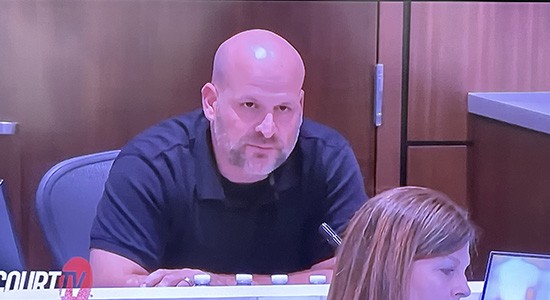
Joshua Kraner
The vehicle knocked him to the ground, and he couldn’t move. Two people helped him, and a policeman took him to the hospital in a squad car. “I had muscle contusions; I had bone bruises. . . I couldn’t walk,” he said.
Mr. Brooks asked Mr. Kraner his standard questions, including, “Would you consider yourself to be an injured party in this matter?”
“Absolutely,” Mr. Kraner replied.
He asked Mr. Kraner if he saw anything on the news about the trial before it began, in particular, reports about Mr. Brooks. The judge stopped the questioning and excused the jury. She asked Mr. Brooks to explain how his questions about news reports were relevant. After listening to a weak explanation about influence by the media, she told him he was free to make that argument in his closing.
“I can’t even get to the questions that need to be answered,” Brooks said.
The judge told him he was making frivolous arguments. “Ask relevant questions; they’ll be answered,” Judge Dorow said.
She excused Mr. Kraner and asked who the next witness was. Mr. Brooks apologized for not being “polished.” He then interrupted the judge several times, but not often enough to have him removed from the court room. As the jury came back in, he again said he objected to being called by the name “Mr. Brooks,” and that the jury deserved to know who the plaintiff was.
Alyssa Gajewski teaches girls at Xtreme Dance. The dance center’s parade formation was in age order, with their youngest “Itty Bitty” group of two- and three-year-olds being pushed in strollers, up to the 8th-grade elite team.
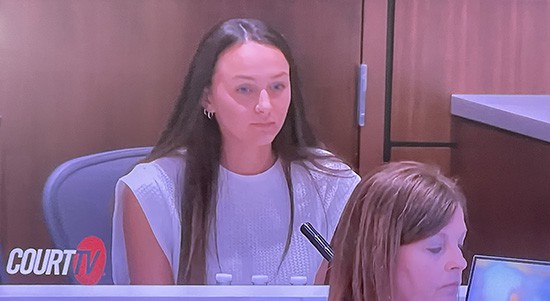
Alyssa Gajewski
Assistant DA Zach Witchow asked Miss Gajewski if there was a point at which the dancers stopped dancing. She said, “Yes.”
He asked why, and she started crying. “There was a car that drove through.” She had to stop to wipe her tears. The prosecutors had Miss Gajewski identify herself in a video, and she continued to cry as they set it up for the jury.
Mr. Brooks tried to object to the video as “hearsay.” Judge Dorow overruled. Miss Gajewski cried as they showed the video of the dancers being run over, and women screaming. Mr. Witchow asked the witness to circle one of the dancers in the video using a touchscreen, and she kept crying as she did so.
Mr. Witchow said, “Judge, before we begin here, I have to step in and request that Mr. Brooks be instructed to stop making comments under his breath. This witness is clearly having an emotional and difficult time testifying, and she doesn’t need to hear that.”
I was unable to hear Mr. Brooks’s comments, so I don’t know what he said, but he was trying to keep the video from being played.
“She can’t hear anything I’m saying.” Mr. Brooks said, shaking his head. Judge Dorow told him the microphones are very good in the courtroom, and she asked him to “please refrain.”
The young woman continued to cry as more video evidence was played for the jury. Mr. Witchow asked her about the aftermath of the incident. As Miss Gajewski began to describe seeing an injured child, and Mr. Brooks claimed this was “hearsay,” Judge Dorow angrily told him which statute he needed to know and said, “It’s not hearsay!”
The impact of the vehicle was “just a blur” said Miss Gajewski, but she remembered the aftermath. “It was pure chaos. Shoes everywhere, poms everywhere, bodies, people screaming, running around. Just chaos.” She picked up a girl who was on the ground because she was afraid more cars might come through.
Miss Gajewski says she is “super close” to some of her students and described the horror of visiting badly injured dancers in the hospital.
On cross-examination, Darrell Brooks’s repetitive, pointless questions — and claims that he didn’t understand the answers — tried Judge Dorow’s patience. She told him, “Ignorance of the law is not something you can use as a valid defense. You keep saying, ‘I don’t understand.’”
“I don’t!” Mr. Brooks said.
“You did this of your own free will. You waived your right to an attorney and the ignorance that you claim is not valid at this point, Sir!”
He continued to babble about a contract, and the judge went off the record. Back on the record after lunch, he brought up subject matter jurisdiction yet again in another tedious exchange.
Mr. Brooks hurts his own case on cross-examination. He asked why, once they got to the hospital, Miss Gajewski’s dance students were lying on the floor. She replied, “Because there were so many people, there wasn’t enough room.”
He asked if they were being tended to and she said, “Nope. Because there were too many people. . . The nurses were doing the best they could.”
Mr. Brooks had objected during direct to Miss Gajewski’s descriptions of injuries of the children at the hospital. How could she know, when she wasn’t a family member? On cross-examination, he got a graphic answer: “Julia had something wrong with her brain because they saw spinal fluid coming out of her nose . . . . The nurses [were] freaking out and rushing her to a CT scan.”
Jaimie Sutton, 23, also taught at Xtreme Dance and marched in the parade. She testified about trying to reunite uninjured children with their parents. A man told her there was an active shooter, so she brought the girls into a restaurant until a policer officer told them it was safe to leave.
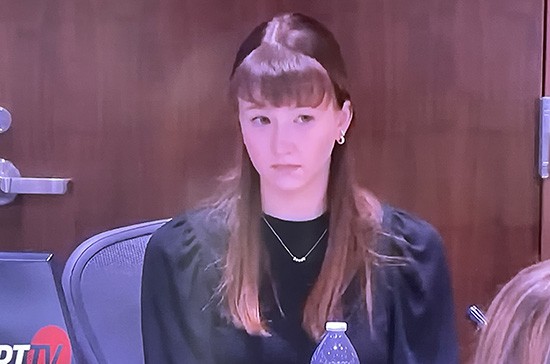
Jaimie Sutton
A prosecutor showed her a picture of a red SUV. She identified a white headband hanging on a side mirror as part of the costume the dancers had been wearing when they were hit.
Detective Michael Carpenter of the Waukesha PD specializes in computer forensics, and had studied video from surveillance cameras along the parade route. He concluded that the SUV was traveling at 33.7 miles per hour.
Mr. Brooks tried to ask questions to undermine this conclusion, but the detective held firm. Mr. Brooks also spent a lot of time discussing Det. Carpenter’s qualifications and asking questions about the technology he used. This may have satisfied Mr. Brooks’ curiosity but did not help his case.
Debora Ramirez, a young Hispanic woman, said she goes to the parade every year, and was there with her children. She heard screaming and looked to her right. She saw a car coming, but she froze and could not move away. The SUV hit her leg and the tire went over her foot, and she fell to the ground. Her children had minor injuries. She said she was crying and had a “mental breakdown” when she got home.
The court went into recess and resumes today.















